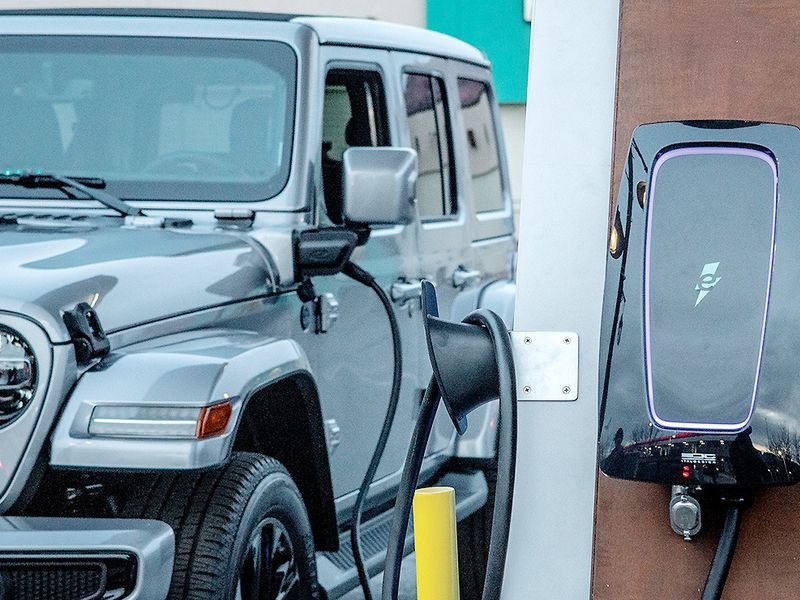
DETROIT — Fiat Chrysler Automobiles wasn’t an early contender in the electric vehicle race, leaving its successor, Stellantis, to play catch-up. But given the slow development of the EV market, dealers and analysts say the automaker’s timing could turn out to be just right.
It wasn’t long ago when FCA CEO Sergio Marchionne was questioning the business case of battery-electric models, while making Alfa Romeo, Jeep and Maserati the center of the company’s EV strategy in a five-year plan introduced just weeks before his 2018 death. Marchionne declared that the Chrysler Pacifica Hybrid demonstrated how the company could electrifyits portfolio, with such plug-in hybrids being the focus and fully electrified options becoming part of the mix for Jeep and Maserati by 2022.
Marchionne was preparing to conservatively ramp up FCA’s electric presence as competitors pursued more aggressive plans. After FCA merged with PSA group to form Stellantis in January, the automaker committed more than $35 billion to electrification and software by 2025.
Some dealers say this is a great moment for Stellantis to pounce with electrified options, pointing to the early success of the Jeep Wrangler 4xe plug-in hybrid as a sign that the market is ripe. They also see the influence of Stellantis CEO Carlos Tavares on the company’s expansive vision that calls for some level of electrification across all of its 14 brands.
John Grant, who owns three Stellantis stores in Las Vegas, said reaction to the Wrangler 4xe convinced him that the time is right to commit further to EVs.
However, Grant understands that Stellantis has “a lot of work ahead.”
“I don’t necessarily think they’re behind,” Grant told Automotive News. “I think they’re going to end up leading the charge. We’re going to be the ones to catch.”
Becoming a leader in the EV world would be a monumental shift for Stellantis. The company is aiming for more than 70 percent of sales in Europe and over 40 percent in the U.S. to be battery-electric or hybrid by 2030. By 2025, 98 percent of the company’s models in Europe and North America are slated to have electrified options.
The market for full EVs is still so small that it’s hard to say Stellantis is late to the party, said Sam Fiorani, vice president of global vehicle forecasting for AutoForecast Solutions, even if Wall Street investors think the company has moved too slowly.
Excluding Tesla, Fiorani said EVs will account for just 1 percent of U.S. sales this year. But as that market grows, he said it looks like Stellantis will be ready.
Ram aims to tap into that volume opportunity with an electric 1500 in 2024, and Dodge will do the same with an electric muscle car the same year.
“I don’t think it’s a closed market yet,” Jessica Caldwell, Edmunds’ executive director of industry insights, said of EVs. “I still feel like anyone could succeed if they put a good vehicle out there with good range, good styling [and] a good price point.”
For plug-in hybrids, Fiorani said Stellantis can take lessons from FCA’s work on the Pacifica Hybrid and Wrangler 4xe. He expects the company to create its own niche within the plug-in hybrid and EV spaces, “just as they’ve made their name in muscle cars, off-road utilities and full-size pickups.”
David Kelleher, chairman of the Stellantis National Dealer Council, said he understood why Marchionne was “decidedly slower” with electrification investments.
“Their strategy, and it was accurate at the time, was the marketplace wasn’t prepared for it and it wasn’t necessary, and that they would keep an eye on it,” Kelleher said.
“Now it’s obviously become much more of a focal point. One of the great parts of this merger was that the Peugeot end had some experiences in this already, and they’re pulling the trigger.”
Kelleher said this is a good moment to make a move, and added that dealers have been begging for Wrangler 4xe inventory.
He believes Stellantis has plenty of time to develop its EVs before customers start demanding them.
“Anybody that’s ahead, good for them, but I don’t think they’re going to gain anything by being ahead of us in that,” Kelleher said. “Five years from now, for the 100 percent EV, the infrastructure has to catch up as well, right? National infrastructure has to catch up and the customer’s intellect on this has to catch up.”
Doug Wilson, owner of Collierville Chrysler-Dodge-Jeep-Ram in Tennessee, said FCA was wise to hold off while it watched the electrified market begin to develop.
“They were smart to wait until the dust cleared a little bit before plowing billions of dollars into the unknown,” Wilson said. “Dealers will instinctively sell whatever it is that we have to sell.”

